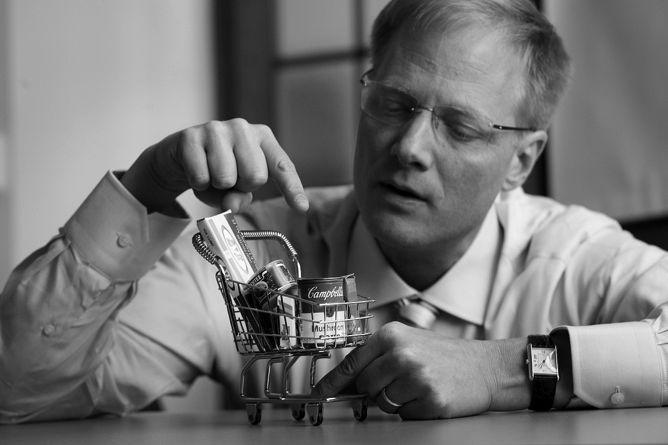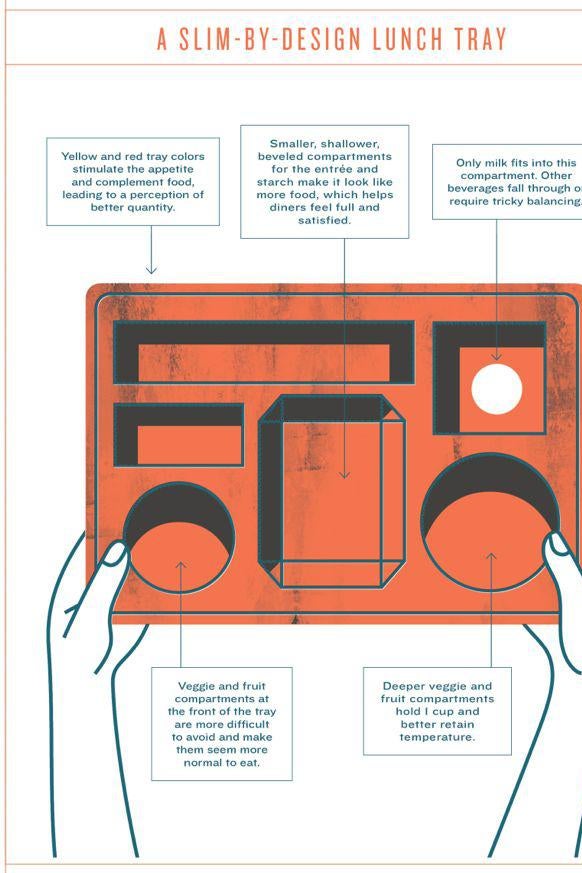Editor’s note: Brian Wansink resigned from his post at Cornell University after an investigation found widespread academic breaches across his 25-year career. We would advise you to read the piece below with caution and skepticism.
In his new book Slim by Design: Mindless Eating Solutions for Everyday Life, director of the Cornell Food and Brand Lab Brian Wansink argues that 25 years of research have convinced him that “becoming slim by design works better than trying to become slim by willpower.” In the book, published this week, he outlines concrete strategies for designing homes, restaurants, grocery stores, workplaces, and schools in ways that surreptitiously encourage healthy eating habits. Here at The Eye, Wansink shares an adapted excerpt from the book that presents an idea for a stealthily redesigned school lunch tray—currently in the prototype phase—that he hopes will help kids make healthy choices without having to think twice.
The Robert Wood Johnson Foundation had been collaborating with an innovative food-service director who was preparing to buy new trays for her school district in St. Paul, Minnesota. Familiar with my book Mindless Eating: Why We Eat More Than We Think, they wondered if the book’s principles could be used to get kids to mindlessly eat better by redesigning a healthier lunch tray.
Coincidentally, we had started down this road a year earlier, but the unfortunate reality of lunch trays is that they’re rapidly being replaced with the disposable variety. Some school lunchrooms can’t wash trays because they have “heat and serve” kitchens. Certain paper companies are really good at persuading schools to buy disposable trays. But a reusable tray that caused kids to eat better might tip the balance back. This call was the excuse we needed to get back on task.
When we ask kids what they want from school lunches, they say: bigger portions of foods they like, foods that are fun or “cool,” and foods that taste good. So the ideal tray would magically make the entrée, the starch, and the dessert look huge and satisfying (even if they were smaller), make the vegetable and fruit look enticing, keep the vegetable hot and the fruit cold, and make everything look like it was going to taste better.
How much you eat, how full you feel, and how much you like it are subjective and partly psychological. Similarly, eating the same amount of food on a smaller plate tricks us into thinking we’re more full. Foods that are the most visible and accessible appear the most natural to eat.
So we created a new tray that makes the entrée and starch look larger (and more satisfying), while it makes the vegetables and fruit appear smaller (and less intimidating); allows a full cup of vegetables to be served and stay hot; makes milk, fruit, and vegetables seem like a natural choice; and reduces the energy costs of cleaning.
If a small plate makes food look bigger, why not create shallower and smaller compartments for the main courses and the starches to make them look huge? Because kids like what’s cool, textured icons of a fruit or vegetable could be printed in the fruit and vegetable compartments.
Next, build the tray so that it would look normal to have both a fruit and vegetable—they wouldn’t have to take both, but the tray would be a daily reminder of the norm. These two compartments could also be moved to the front edge of the tray, flanking the entrée, to make them look integral to the meal.

Courtesy of Jason Koski/Cornell University
To make milk seem like the norm, it’s easy to restyle the beverage compartment so that it holds only square milk cartons, and the rounded bottles of other beverages would fit awkwardly or fall through.
Research about how color influences how much you like food isn’t clear-cut, but people intuitively believe that yellow, gold, and red can stimulate appetite and may complement the look of some foods. If nothing else, offering the trays in bright school colors might make lunch seem more fun.
Finally, most standard reusable lunch trays fit singly through automated dishwashers. By reshaping trays to be longer and skinnier, two could be vertically stacked side by side and washed in a single slot. This would save energy and washing costs from 15 to 30 percent, possibly enough incentive to bring some schools back around to reusable trays.
Adapted from the book Slim by Design: Mindless Eating Solutions for Everyday Life by Brian Wansink, Ph.D. Copyright (c) 2014 by Brian Wansink, Ph.D. William Morrow, an imprint of HarperCollins Publishers. Reprinted by permission.
